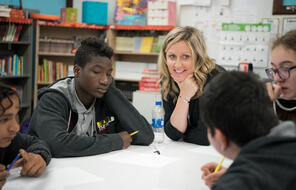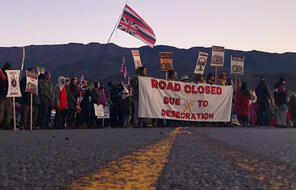Resistance
Shortly after the residential schools system began, parents, who had for the most part been reluctant to send their children away, began to voice their discontent with the schools. This was especially true for graduates of these schools, people who had experienced firsthand the harsh and sometimes abusive treatment by residential school staff members. 1 Many Indigenous leaders believed that the residential schools were a violation of the treaties between the government and First Nations . When the government signed these treaties, it promised to provide education for children on the reserves . Even those who had wanted government education did not envision a situation in which the children would be taken away from them to undergo a complete cultural transformation. 2 The law, however, was clear: after 1920, all First Nations children had to be educated. In many cases, parents were forced to give up their children under threat. Letters from students, even though they were censored by school staff, brought news about the poor conditions and harsh discipline to the parents. Indigenous parents then brought their complaints to a missionary or to the Department of Indian Affairs. Sometimes the complaints would lead to an investigation of the school and some action, such as an increase in food supplies or the dismissal of an inappropriate staff member. Sometimes family or members of the community would go directly to the principal of a school and demand that their concerns be addressed.
Some parents went even further and removed their children from residential schools, placing them in day schools on the reserve or in schools of a different denomination that they felt were kinder to the children. Some families went so far as to hide their children when the Indian agents came searching for them. Residential schools historian James R. Miller conducted an interview with a man who attended Whitehorse Baptist Mission School from 1951 to 1953. The grandmother of the interviewee protected her grandson from missionaries when they came to her house searching for him. The man recalls:
My grandmother was very, very upset. I distinctly recall the third time—my final year at the Baptist Mission school—when these missionaries came again to take me away, I was at that time living with my grandmother and my aunt . . . who was a blind person. They in a sense were my immediate family. . . . When these missionaries came to the door and they said, “Well, we have permission to take [name deleted] to this Whitehorse Baptist Mission school,” and they came to physically take me out of my home, I hung on to my grandmother’s legs. I was crying, of course, and my grandmother was very angry. She was quite old—in her sixties, probably.
I remember her taking her tut as we called it, walking cane—and beating this missionary, this white missionary over the backside, and saying, ‘You leave my grandson alone. You are not taking him anywhere.’ And my aunt Pat came out—and she was blind then, too—and saying the same thing, supporting her mother. And saying that you cannot take this child from this home no matter what permission you have. They didn’t produce any written document at the time . . . My grandmother stood by me, and she was able to drive these white missionaries out of our home. And they finally left in defeat. And this is one Indian child who didn’t get to go to the Whitehorse Baptist Mission school forever after. 3
Students would express their displeasure, as children tend to do, by not cooperating with school authorities and through small acts of defiance. They would sometimes give their teachers derogatory nicknames in their native languages, which was amusing to them and their peers, since the teachers in question did not understand Indigenous languages. In doing so, they not only mocked the authority of the system but also kept alive the very thing the schools sought to eradicate. Continuing to speak their languages and choosing not to forget them, both in school and on the reserve, was often another conscious decision of defiance. Lillian Elias, who attended residential school in Aklavik, a part of the Northwest Territories, tells of her refusal to have her language beaten out of her:
When they roughed us girls up that’s when I really would get scared. I never got roughed up myself, but I got put in a post a couple of times because I said one word in my language. I think that’s why I really fought to keep my language. Because they didn’t want me to speak it I thought to myself, “you’re not going to keep me from speaking my language”, and so I really picked it right back up when I got out of there. I picked it up with my grandparents. I lived with my grandparents all the time. My grandparents being there, and my mom and dad and my aunties and my uncles, we had like a little community. . . . I got strong. I’m very powerful, I must say, I am today because of when I think back and I think that I couldn’t do this, I couldn’t do that, that’s why I never lost my language because I wasn’t going to let them beat me. I wasn’t going to let them take everything away from me. They could take my pride and things like that but not my language. 4
A few students also refused to cooperate with faculty and staff by not participating in class, ignoring their coursework, or not eating their meals. Also common was what Celia Haig-Brown defines as “organized crime." 5 Among these crimes was theft, particularly stealing food from the kitchens. Students who had access to the food supply would sneak out food and then develop a system to barter it. Although these acts were brought about by pure hunger and elicited guilt afterward, many students stood in solidarity with one another and did not report these actions.
A more extreme way of resisting for those who did not attempt to run away was through acts of arson. In rare instances, students burned their school down, as was the case at the Mohawk Institute, which was set on fire twice. 6 Pupils believed that setting their institutions on fire was a solution to their problems, as outbreaks of fire would either destroy the school and close it down altogether, leaving students free to leave, or would result in expulsion for the culprits, ensuring that they did not have to return. 7
These acts allowed parents and students alike to speak out, as well as act out, against a system that took away their ability to make decisions about their lifestyle and method of education.
Connection Questions
- The title of this reading is “Resistance.” What does the word mean in the context of the Indian Residential Schools? How would you describe the behaviours in this reading—as resistance? Defiance? Disobedience? What is the line between resistance and crime?
- What were the forms of resistance that parents and students displayed in residential schools? How effective do you think they were? What else could Indigenous Peoples do to protest the decisions of the government? What made protest and resistance so difficult?
- What do you think drives individuals and groups to engage in acts of resistance in spite of the risks, such as corporal punishment?
- residential schools system residential schools system: Beginning in 1883, the federal government sought a system to enroll Indigenous children in schools. The residential schools system was part of a larger government agenda to assimilate Indigenous people into settler society by way of education. Relying almost exclusively on churches to provide the teachers, administrators, and religious instructors, the system was severely underfunded and marked by inferior educational standards and achievement: neglect, malnutrition, abuse, and disease were widely reported. In recent years, researchers discovered that some schools even carried out dangerous medical experiments. It is also estimated that more than 6,000 students died of disease and abuse while enrolled. Over a 150-year span, the government and churches operated close to 150 schools where some 150,000 Indigenous youth were enrolled.
- 1Elizabeth Graham, ed., The Mush Hole: Life at Two Indian Residential Schools (Ontario: Heffle Publishing, 1997), 9; see also the reports of Rev. James Musgrove, principal of Mt. Elgin, 234–35.
- First NationsFirst Nations: have lived in North America for tens of thousands of years. Today, the term refers to some 617 different communities, traditionally composed of groups of 400 or so. These nations enjoy a richness and diversity of identity, culture, and customs. Many view North America as their traditional homeland and do not recognize aspects of US and Canadian sovereignty. Alongside the Métis and Inuit Peoples, First Nations are part of a larger grouping officially called the Aboriginal Peoples of Canada.
- reservesreserves: The key tool of a common colonial strategy, reserves were small, barely habitable areas where the colonizers sought to manage the people they dispossessed. In Canada, the 1850s saw a series of legislative enactments redefining the boundaries of First Nations communities, property, and land use, which increased pressure to relocate to reserves. Lack of investment and poor government services exacerbated First Nations isolation, leaving many reserves economically depressed and prone to violence and crime.
- 2Megan Sproule-Jones, “Crusading for the Forgotten: Dr. Peter Bryce, Public Health, and Prairie Native Residential Schools,” Canadian Bulletin of Medical History 13 (1996), 208.
- day schoolsday schools: Alongside residential schools and industrial schools, day schools were part of the residential school system for Indigenous children in Canada. Often located on the reserves, these schools served about two-thirds of Indigenous students throughout the history of the system. They were operated by both municipal authorities and the churches, and they attempted to reach the same goals as the Indian Residential Schools: Christianization and assimilation. Many of the troubles and abuses found in the residential schools were also found in the day schools.
- 3Quoted in James R. Miller, Shingwauk’s Vision: A History of Native Residential Schools (Toronto: University of Toronto Press, 1996), 343.
- 4Lillian Elias, “We Were So Far Away: The Inuit Experience of Residential Schools,” Legacy of Hope Foundation. Reproduced by permission of Legacy Hope Foundation.
- 5Celia Haig-Brown, Resistance and Renewal: Surviving the Indian Residential School (Vancouver: Arsenal Pulp Press, 2002), 102.
- 6Elizabeth Graham, ed., The Mush Hole: Life at Two Indian Residential Schools (Waterloo, Ontario: Heffle Publishing, 1997), 100.
- 7Elizabeth Graham, ed., The Mush Hole: Life at Two Indian Residential Schools (Waterloo, Ontario: Heffle Publishing, 1997), 23, 31.
How to Cite This Reading
Facing History & Ourselves, "Resistance," last updated September 20, 2019.
















